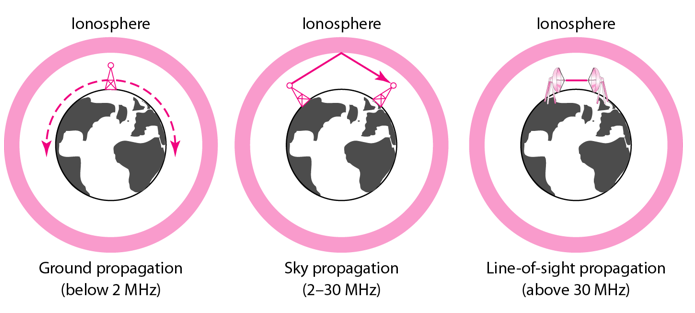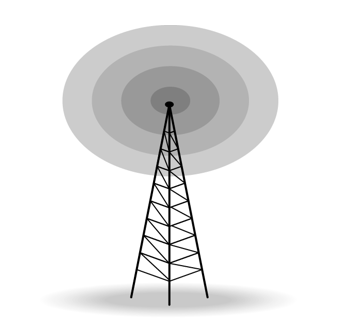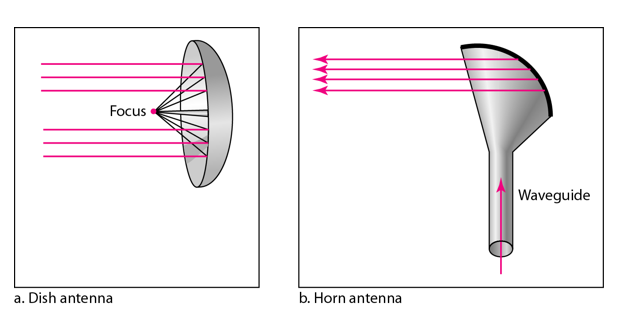2.2 Un-Guided Media: Wireless Communication Infrared Communication Microwave Communication
Unguided medium transport electromagnetic waves without using a physical conductor. This type of communication is often referred to as wireless communication. Signals are normally broadcast through free space and thus are available to anyone who has a device capable of receiving them.
The below figure shows the part of the electromagnetic spectrum, ranging from 3 kHz to 900 THz, used for wireless communication.

Unguided signals can travel from the source to the destination in several ways: Gound propagation, Sky propagation and Line-of-sight propagation as shown in below figure.

Propagation Modes
- Ground Propagation: In this, radio waves travel through the lowest portion of the atmosphere, hugging the Earth. These low-frequency signals emanate in all directions from the transmitting antenna and follow the curvature of the planet.
- Sky Propagation: In this, higher-frequency radio waves radiate upward into the ionosphere where they are reflected back to Earth. This type of transmission allows for greater distances with lower output power.
- Line-of-sight Propagation: in this type, very high-frequency signals are transmitted in straight lines directly from antenna to antenna.
We can divide wireless transmission into three broad groups:
- Radio waves
- Micro waves
- Infrared waves
Radio Waves
Electromagnetic waves ranging in frequencies between 3 KHz and 1 GHz are normally called radio waves.
Radio waves are omnidirectional. When an antenna transmits radio waves, they are propagated in all directions. This means that the sending and receiving antennas do not have to be aligned. A sending antenna send waves that can be received by any receiving antenna. The omnidirectional property has disadvantage, too. The radio waves transmitted by one antenna are susceptible to interference by another antenna that may send signal suing the same frequency or band.
Radio waves, particularly with those of low and medium frequencies, can penetrate walls. This characteristic can be both an advantage and a disadvantage. It is an advantage because, an AM radio can receive signals inside a building. It is a disadvantage because we cannot isolate a communication to just inside or outside a building.
Omnidirectional Antenna for Radio Waves
Radio waves use omnidirectional antennas that send out signals in all directions.

Applications of Radio Waves
- The omnidirectional characteristics of radio waves make them useful for multicasting in which there is one sender but many receivers.
- AM and FM radio, television, maritime radio, cordless phones, and paging are examples of multicasting.
Micro Waves
Electromagnetic waves having frequencies between 1 and 300 GHz are called micro waves. Micro waves are unidirectional. When an antenna transmits microwaves, they can be narrowly focused. This means that the sending and receiving antennas need to be aligned. The unidirectional property has an obvious advantage. A pair of antennas can be aligned without interfering with another pair of aligned antennas.
The following describes some characteristics of microwaves propagation:
- Microwave propagation is line-of-sight. Since the towers with the mounted antennas need to be in direct sight of each other, towers that are far apart need to be very tall.
- Very high-frequency microwaves cannot penetrate walls. This characteristic can be a disadvantage if receivers are inside the buildings.
- The microwave band is relatively wide, almost 299 GHz. Therefore, wider sub-bands can be assigned and a high date rate is possible.
- Use of certain portions of the band requires permission from authorities.
Unidirectional Antenna for Micro Waves
Microwaves need unidirectional antennas that send out signals in one direction. Two types of antennas are used for microwave communications: Parabolic Dish and Horn.

A parabolic antenna works as a funnel, catching a wide range of waves and directing them to a common point. In this way, more of the signal is recovered than would be possible with a single-point receiver.
A horn antenna looks like a gigantic scoop. Outgoing transmissions are broadcast up a stem and deflected outward in a series of narrow parallel beams by the curved head. Received transmissions are collected by the scooped shape of the horn, in a manner similar to the parabolic dish, and are deflected down into the stem.
Applications of Micro Waves
Microwaves, due to their unidirectional properties, are very useful when unicast(one-to-one) communication is needed between the sender and the receiver. They are used in cellular phones, satellite networks and wireless LANs.
There are 2 types of Microwave Transmission :
- Terrestrial Microwave
- Satellite Microwave
Advantages of Microwave Transmission
- Used for long distance telephone communication
- Carries 1000's of voice channels at the same time
Disadvantages of Microwave Transmission
- It is very costly
Terrestrial Microwave
For increasing the distance served by terrestrial microwave, repeaters can be installed with each antenna .The signal received by an antenna can be converted into transmittable form and relayed to next antenna as shown in below figure. It is an example of telephone systems all over the world

There are two types of antennas used for terrestrial microwave communication :
1. Parabolic Dish Antenna
In this every line parallel to the line of symmetry reflects off the curve at angles in a way that they intersect at a common point called focus. This antenna is based on geometry of parabola.
2. Horn Antenna
It is a like gigantic scoop. The outgoing transmissions are broadcast up a stem and deflected outward in a series of narrow parallel beams by curved head.
Satellite Microwave
This is a microwave relay station which is placed in outer space. The satellites are launched either by rockets or space shuttles carry them.
These are positioned 36000 Km above the equator with an orbit speed that exactly matches the rotation speed of the earth. As the satellite is positioned in a geo-synchronous orbit, it is stationery relative to earth and always stays over the same point on the ground. This is usually done to allow ground stations to aim antenna at a fixed point in the sky.
Features of Satellite Microwave
- Bandwidth capacity depends on the frequency used.
- Satellite microwave deployment for orbiting satellite is difficult.
Advantages of Satellite Microwave
- Transmitting station can receive back its own transmission and check whether the satellite has transmitted information correctly.
- A single microwave relay station which is visible from any point.
Disadvantages of Satellite Microwave
- Satellite manufacturing cost is very high
- Cost of launching satellite is very expensive
- Transmission highly depends on whether conditions, it can go down in bad weather
Infrared Waves
Infrared waves, with frequencies from 300 GHz to 400 THz, can be used for short-range communication. Infrared waves, having high frequencies, cannot penetrate walls. This advantageous characteristic prevents interference between one system and another, a short-range communication system in on room cannot be affected by another system in the next room.
When we use infrared remote control, we do not interfere with the use of the remote by our neighbours. However, this same characteristic makes infrared signals useless for long-range communication. In addition, we cannot use infrared waves outside a building because the sun's rays contain infrared waves that can interfere with the communication.
Applications of Infrared Waves
- The infrared band, almost 400 THz, has an excellent potential for data transmission. Such a wide bandwidth can be used to transmit digital data with a very high data rate.
- The Infrared Data Association(IrDA), an association for sponsoring the use of infrared waves, has established standards for using these signals for communication between devices such as keyboards, mouse, PCs and printers.
- Infrared signals can be used for short-range communication in a closed area using line-of-sight propagation.









Comments
Post a Comment